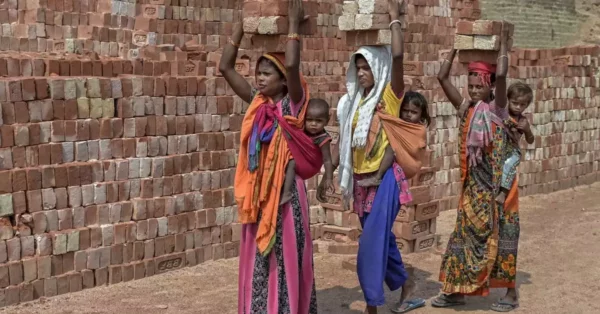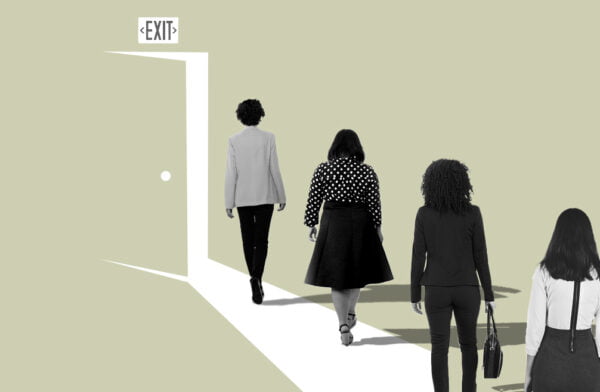Trillions at stake as Indian women disappear from the workforce

Trillions at stake as Indian women disappear from the workforce
Sanchuri Bhuniya from India defied her parents’ wishes to settle down for years. She didn’t want to be a housewife; she wanted to travel and make money. As a result, Bhuniya snuck out of her remote hamlet in eastern India in 2019.
She travelled hundreds of miles south to Bengaluru, where she found employment in a garment factory for $120 per month. Her profession gave her a sense of freedom. “I bolted,” she explained. “That was the only way I could get there.” With the emergence of Covid-19, that life of financial freedom ended abruptly. To combat illnesses, Prime Minister Narendra Modi imposed a nationwide shutdown in 2020, shutting down practically all enterprises.
Over 100 million Indians lost their jobs in a matter of weeks, including Bhuniya, who was forced to return to her village and never found another steady job. As the world recovers from the pandemic, analysts point to a disturbing statistic: failing to restore jobs for women, who have been less likely than males to return to work, could slash global economic growth by trillions of dollars.
The outlook is especially dismal in developing countries like India, where female labour force participation has dropped so dramatically that it now ranks alongside war-torn Yemen. This week’s Pay Check podcast looks at how the coronavirus has exacerbated a disturbing trend in the world’s second-most populous country.
According to data published by the World Bank, the number of working women in India decreased from 26% to 19% between 2010 and 2020. As the number of infections increased, a poor situation worsened: Mumbai economists project that female employment will drop to 9% by 2022. This is bad news for India’s economy, which had already begun to deteriorate prior to the outbreak.
Modi has prioritised job creation, urging the country to pursue amrit kaal or a golden period of progress.
On the other hand, his administration has made little headway in increasing the prospects for working women. This is especially true in rural regions, where more than two-thirds of India’s 1.3 billion people live, conservative values predominate, and jobs have been vanishing for years.
Despite the country’s fast economic growth, women have found it difficult to make the move to work in cities. Closing the 58-percentage-point employment gap between men and women may boost India’s GDP by nearly a third by 2050. A recent Bloomberg Economics estimate corresponds to over $6 trillion in constant US dollar terms.
The country’s desire to become a competitive producer for global markets will be derailed if nothing is done. Despite the fact that women account for 48% of the population in India, they only contribute roughly 17% of GDP, compared to 40% in China. India is a perfect example of a global phenomenon. Women were more likely than males to lose their jobs around the world during the pandemic, and their recovery has been slower.
According to Bloomberg Economics, policy measures that address gender gaps and increase the number of working women – such as increased access to education, child care, or flexible work arrangements – would add roughly $20 trillion to global GDP by 2050. The pandemic had severe effects on workers like Bhuniya, 23. After losing her work, she struggled to buy food in Bengaluru and eventually returned to her distant hamlet of Patrapali in the state of Odisha. Bhuniya does not believe she will have another chance to go.
Her family is concerned about her safety as a single woman living in a distant city because she no longer has a consistent income. “My mother would curse me if I run away again,” Bhuniya remarked. “There’s nothing left now. My bank account is depleted, and there is little labour available in the village.” The story has reverberations all over India.
Rosa Abraham, an economics professor at Bengaluru’s Azim Premji University, followed almost 20,000 people as they navigated the labour market during the pandemic. She discovered that after the initial lockout, women were several times more likely than men to lose their jobs, and significantly less likely to find work once the restrictions were lifted.
Increased family responsibilities, a shortage of childcare options following school closures, and an increase in marriages – which typically limit women’s autonomy in India – all contribute to the disparity in outcomes. “When men are confronted with such a massive economic blow, they have a fallback choice,” Abraham explained.
“They can move between different types of jobs. Women, on the other hand, have no such safety net. They are unable to manoeuvre the labour market as well as men.” Dreams of freedom or a well-paid office job were replaced by “distress-led employment,” which was effectively unpaid work on a family farm or housekeeping. Prior to the epidemic, Indian women did around ten times as much care work as males, or almost three times the global norm.
“It’s a sad scenario,” Abraham remarked, “that the decision to work is often not in the hands of the lady herself.” Part of the reason for the fall in workforce participation is cultural. Families who could afford to retain women at home as Indians became wealthy did so, believing it would bestow social rank. Those at the bottom of society, on the other hand, are still considered as potential earners.
However, they are more likely to work in low-wage or unpaid employment outside of the official sector. Their labour is not recorded in official statistics. In many areas, patriarchal values are still in place, and girls are still stigmatised. Sex-selective abortions are nevertheless widespread, despite the fact that they are banned.

Indian men typically believe “it’s not very manly if their wife contributes to the household income,” according to Akhina Hansraj, senior programme manager at Akshara Centre, a Mumbai-based group that fights for gender justice. Hansraj explained, “They aim to develop this dependency.” “People believe that if women receive an education, they would be able to work and become financially independent and that they will no longer obey and respect the family.”
In India, where most marriages are still planned, marriage is a stumbling block. The country’s leading matrimonial websites reported a surge in new registrations after the first shutdown in 2020. According to government data, weddings among minors and young adults increased by 80 per cent in some areas, many of which are unlawful under Indian law.
Madhu Sharma, a Hindi teacher at Anupshahr’s Pardada Pardadi Educational Society, a girls’ school, claimed she might interfere in three child marriages per year. When the campus was closed due to the pandemic, the number of students climbed three to fourfold. “Before Covid, students were in constant contact with their teachers as well as with me,” she explained. “Keeping in touch with the children after Covid, when they had to stay home, became a major struggle.” Marriage was frequently favoured due to financial factors.
Parents might have shorter, less-expensive festivities at home rather than the multi-day celebrations that are popular even in the lowest corners of society due to social alienation and warnings against mass gatherings. Some families married off daughters at the worst of the pandemic because they couldn’t afford to feed another mouth. Getting married before graduating from high school might influence the course of a student’s life, according to Sharma. When a woman marries in India, she usually lives with her husband and in-laws.
This can make it tough to leave isolated areas where choices are routinely policed, and job possibilities are sparse. Sharma stated, “We attempt to teach our students.” “We tell them that if they study hard, they will be successful. We’ll outline what they’ll be doing if they don’t.
We tell them, ‘The rest is up to you.’ You live your life the way you want it to be lived.” Modi launched the “Beti Bachao, Beti Padhao” campaign in 2015, which roughly translates to “Save Our Daughters, Teach Our Daughters.” It’s a programme aimed at keeping girls in school and lowering the rate of sex-selective abortion. The government has also made an effort to prevent children from marrying. Modi’s administration proposed raising the legal marriage age for women from 18 to 21, the same as it is for men, last year.
On the other hand, national laws are a faraway abstraction in many villages. Local panchayats, essentially a council of elders, almost all of whom are men, continue to determine and enforce local customs. While Modi’s drive to educate India’s daughters drew a lot of attention, subsequent government audits revealed that a large portion of the initiative’s cash went unused. The strain on women is immense, even in major metropolises where literacy rates are much higher and employment is plentiful.

Anjali Gupta, a Mumbai resident, said she was barely holding on. The coronavirus lockdowns first wreaked havoc on her family’s tiny grocery business, forcing them to spend all of their money to stay afloat. Her parents then began pressuring Gupta and her three sisters to marry, afraid that they would be left penniless if they did not. Gupta attempted to persuade them.
She’d already spent nearly $1,300 on a master’s degree in pharmacology and nutrition. She was undergoing training with a homoeopathic physician. She was looking for a job. Gupta added, “I mentioned that my position is different, that my generation is different.”
Gupta’s father begged with her to drop out of school when an uncle died of the coronavirus, a prospect that caused migraines and interminable debates. Her parents began bringing potential grooms to her house. Gupta is concerned that her inertia will eventually win out. “It shouldn’t be this way,” she expressed her dissatisfaction. “I want to learn and do more. I’m only 22 years old.”




